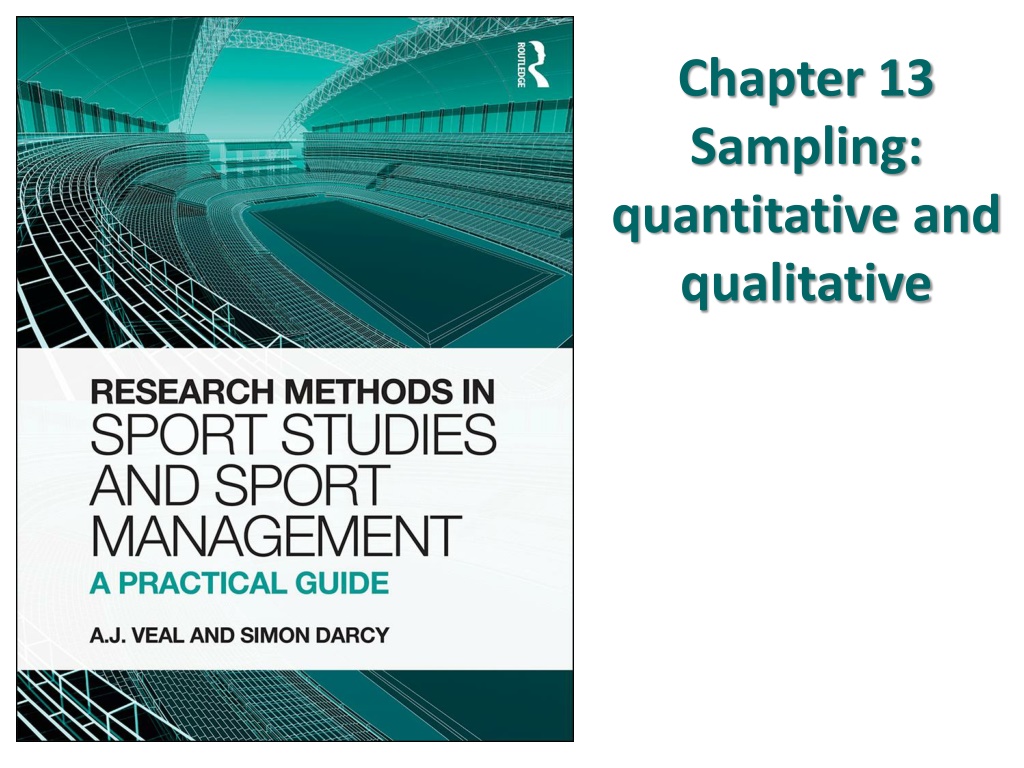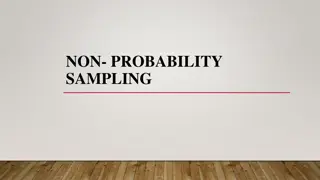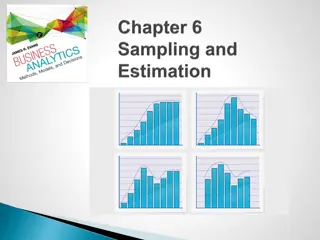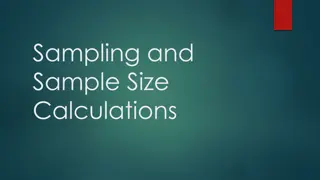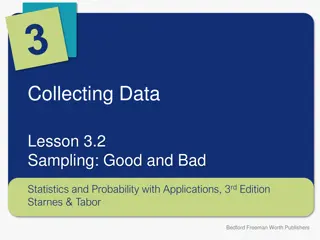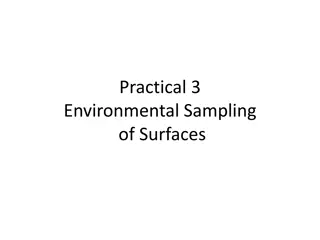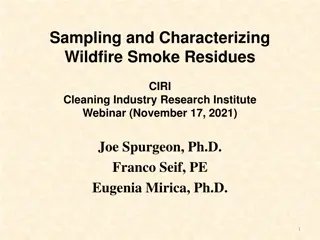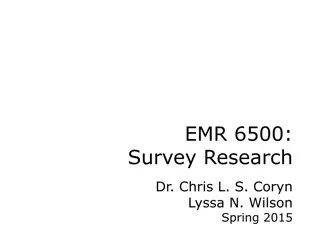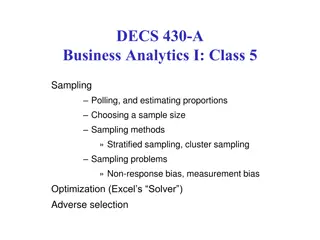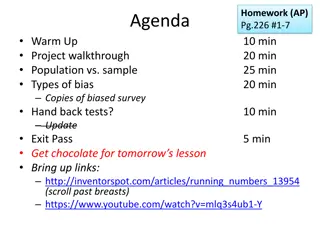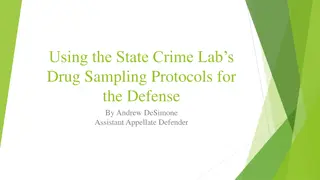Understanding Sampling Techniques in Research
This content delves into the significance of sampling in research, covering quantitative and qualitative approaches. It discusses key concepts such as samples, populations, representativeness, sample size, and weighting. Various sampling methods for different types of research, including household surveys and telephone surveys, are explained in detail. The aim is to provide a comprehensive understanding of how to ensure samples are representative of populations in research projects.
- Research methods
- Sampling techniques
- Quantitative research
- Qualitative research
- Survey methodologies
Uploaded on Sep 26, 2024 | 0 Views
Download Presentation

Please find below an Image/Link to download the presentation.
The content on the website is provided AS IS for your information and personal use only. It may not be sold, licensed, or shared on other websites without obtaining consent from the author. Download presentation by click this link. If you encounter any issues during the download, it is possible that the publisher has removed the file from their server.
E N D
Presentation Transcript
Chapter 13 Sampling: quantitative and qualitative
CONTENTS Samples and populations Representativeness Sample size Weighting Sampling for qualitative research
Samples and populations Population: Total category of subjects that is the focus of attention in a particular research project (can be non-human) Sample: A number of subjects drawn from the population Two key issues: 1.What procedures must be followed to ensure that the sample is representative of the population? 2.How large should the sample be? A. J. Veal & S. Darcy (2014) Research Methods for Sport Studies and Sport Management: A practical guide. London: Routledge
Representativeness Achieved by Random sampling: A systematic selection process which ensures that all members of the population have an equal chance of inclusion in the sample Designed to ensure representativeness An unrepresentative sample is:biased How is random sampling achieved in practice? A. J. Veal & S. Darcy (2014) Research Methods for Sport Studies and Sport Management: A practical guide. London: Routledge
Sampling for household surveys Ideally Eg. 10 million population sample of 1000: all 10 m. names put in a drum and 1000 drawn. In practice: For national/regional surveys multi-stage sampling used 1. Select states/regions 2. Within state/region select local government areas (lga) or constituencies/electorates 3. Within lgas or constituencies/electorates for face-to-face interviews select streets (telephone surveys select numbers at this point) 4. Select clusters of 10-15 houses A. J. Veal & S. Darcy (2014) Research Methods for Sport Studies and Sport Management: A practical guide. London: Routledge
Sampling for telephone surveys Telephone numbers selected at random from telephone directory For large-scale surveys: automated by Computer- Aided telephone Interviewing (CATI) Requires access to electronic directory with residential/business numbers identified No directories for mobile phones For household and telephone surveys: select person in household randomly: eg person with next birthday A. J. Veal & S. Darcy (2014) Research Methods for Sport Studies and Sport Management: A practical guide. London: Routledge
Sampling for site/user/visitor surveys 1. ISUM: Interviewer stationary user mobile: eg. interviewing at entrance/exit Sample by selecting: next person to pass entrance/exit point 2. USIM: User stationary interviewer mobile eg. interviewing people on a beach Interviewers should have a set route/rules to follow eg. interview every third person/group 3. Handouts Handing out questionnaires to (all) visitors for self-completion Not generally recommended unless closely supervised generally very poor response rates A. J. Veal & S. Darcy (2014) Research Methods for Sport Studies and Sport Management: A practical guide. London: Routledge
Sampling for street/quota surveys Can be used when data are available on key characteristics of population: age/sex structure of a community from Census Interviewing target numbers determined by population characteristics Eg. if Population Census indicates 12% retired: if overall sample size is 200: interview 24 retired people A. J. Veal & S. Darcy (2014) Research Methods for Sport Studies and Sport Management: A practical guide. London: Routledge
Sampling for mail surveys Sample from mail-out list 100% sample often used A. J. Veal & S. Darcy (2014) Research Methods for Sport Studies and Sport Management: A practical guide. London: Routledge
Sampling for complex events and destination surveys Different components will conform to above guidelines mostly site surveys Problem lies in combining data from different sources for an overall result, if required. A. J. Veal & S. Darcy (2014) Research Methods for Sport Studies and Sport Management: A practical guide. London: Routledge
Sampling/ random assignment for experimental research Samples of subjects often convenience samples eg. Students Assignment to control and experimental groups: Use of random numbers Online: eg. www.random.org A. J. Veal & S. Darcy (2014) Research Methods for Sport Studies and Sport Management: A practical guide. London: Routledge
Sample size Required sample size is not related to population size (except for small populations see later) Criteria: o The required level of precision in the results o The level of detail in the proposed analysis o The available budget A. J. Veal & S. Darcy (2014) Research Methods for Sport Studies and Sport Management: A practical guide. London: Routledge
Level of precision confidence intervals A statistic (finding) from a sample survey is an estimate of the population statistic In a randomly drawn sample the sample value has a certain probability of being in a certain range either side of the population value Eg. 95% probability of being within 2 standard errors See Normal distribution Theoretical: imagine drawing lots of samples: some would be accurate, some not Discussed further in Ch. 17 A. J. Veal & S. Darcy (2014) Research Methods for Sport Studies and Sport Management: A practical guide. London: Routledge
Normal curve (Fig. 13.1) NUMBER OF SAMPLES 95% 2.5% 2.5% +1 +2 +3 +4 -4 -3 -2 -1 Popn Value Standard errors Standard errors A. J. Veal & S. Darcy (2014) Research Methods for Sport Studies and Sport Management: A practical guide. London: Routledge
Confidence intervals (CIs) (Table 13.1: Extract) Sample size (N) Percentages found from sample ( results ) 40/60% 30/70% 20/80% Confidence intervals (CIs) + % +4.3 +4.0 +3.5 50% 10/90% 5/95% 2/98% 1/99% 500 +4.4 +2.6 +1.9 +1.2 +0.9 A. J. Veal & S. Darcy (2014) Research Methods for Sport Studies and Sport Management: A practical guide. London: Routledge
Confidence intervals (CIs) (Table 13.1) Sample size (N) Percentages found from sample ( results ) 50% 40/60% 30/70% 20/80% 10/90% 5/95% 2/98% 1/99% Confidence intervals (CIs) + % +4.0 +3.5 500 +4.4 +4.3 +2.6 +1.9 +1.2 +0.9 So CI for 20% finding is 30% +4.0 = a range of: 26.0% to 34.0%. CI is not related to population size. NB. CI for p = CI for 100-p eg. CI is the same for 40% and 60% CI for 50% is the largest in absolute terms This table refers to 95% probability CIs others can be calculated eg. 99% A. J. Veal & S. Darcy (2014) Research Methods for Sport Studies and Sport Management: A practical guide. London: Routledge
Confidence intervals (CIs) contd (Table 13.1) Sample size (N) Percentages found from sample ( results ) 50% 40/60% 30/70% Confidence intervals (CIs) + % +4.0 +3.5 +2.0 +1.7 20/80% 10/90% 5/95% 2/98% 1/99% 500 2000 +4.4 + 2.2 +4.3 +2.1 +2.6 +1.3 +1.9 +1.0 +1.2 +0.6 +0.9 +0.4 So to halve the CI it is necessary to increase the sample fourfold. A. J. Veal & S. Darcy (2014) Research Methods for Sport Studies and Sport Management: A practical guide. London: Routledge
Confidence intervals (CIs) contd (Table 13.2) Table 13.1 can be changed to present necessary sample size for a given CI see Table 13.2 Percentages found from sample ( results ) 40/60% 30/70% 20/80% Conf. Interval 50% 10/90% 5/95% 1/99% Necessary sample sizes +1 +2 9600 2400 9216 2304 8064 2016 6144 1536 3456 864 1824 456 380 * +4 600 576 504 384 216 114 * +8 150 144 126 96 53 * * A. J. Veal & S. Darcy (2014) Research Methods for Sport Studies and Sport Management: A practical guide. London: Routledge
Suggested appendix on sample size and CIs See Appendix 13.1 table indicating levels of Cis statement indicating that they have been taken into account A. J. Veal & S. Darcy (2014) Research Methods for Sport Studies and Sport Management: A practical guide. London: Routledge
Detail of proposed analysis Sample size % CI Range, % Comment Survey with sample of 200 200 Bowling 20 +5.5 14.5 25.5 Ranges overlap Tennis 30 +6.3 23.7 36.3 Survey with sample of 500 500 Bowling 20 +3.5 16.5 23.5 Ranges do not overlap Tennis 30 +4.0 26.0 34.0 A. J. Veal & S. Darcy (2014) Research Methods for Sport Studies and Sport Management: A practical guide. London: Routledge
Budget Key issue: halving the CI requires 4-fold increase in sample size Eg. N = 250 CI for 50% = +6.2 Survey Cost = 200 x $20 = $5000 N = 1000 CI for 50% = +3.1 Survey Cost = 1000 x $20 = $20,000 If resources not available for adequate sample size, consider: Pilot/exploratory study Qualitative study A. J. Veal & S. Darcy (2014) Research Methods for Sport Studies and Sport Management: A practical guide. London: Routledge
Confidence intervals and population estimates (Table 13.3) Item Source Number Population Census 500,000 Sample Survey 1,000 % visiting facility/year Survey 12% % confidence interval Table 13.1 + 2.0% Estimated no. persons 12% of 500,000 60,000 CI in no. persons + 2% of 500,000 + 10,000 CI as % of persons (10,000/60,000) x 100 + 16.7% Frequency of visit/year Survey 2.5 Estimated total visits Calc.: (12% of 500,000) x 2.5 150,000 CI in no. visits Calc: (2% of 500,000) x 2.5 +25,000 CI in % visits Cals.: (25,000/150,000) x 100 +16.7% A. J. Veal & S. Darcy (2014) Research Methods for Sport Studies and Sport Management: A practical guide. London: Routledge
Sampling for small populations CIs are affected by population size if population is below about 50,000 See Table 13.3 A. J. Veal & S. Darcy (2014) Research Methods for Sport Studies and Sport Management: A practical guide. London: Routledge
Sample size & population size: small popns(Table 13.3) Population size Minimum sample size to achieve CI of +5% or +1% on a sample finding of 50% +5% 384 384 384 384 383 381 370 357 278 80 +1% 9602 9584 9511 9422 8761 8056 4899 3288 906 99 Infinite 5 million 1 million 500,000 100,000 50,000 10,000 5000 1000 100 A. J. Veal & S. Darcy (2014) Research Methods for Sport Studies and Sport Management: A practical guide. London: Routledge
Weighting (Tables 13.4 & 13.5) Example: one survey at a site Time # of % Actual # of users (counts) 25 240 110 60 435 % Interviews 10 12 11 12 45 9-11 am 11.01-1 pm 1.01-3 pm 3.01-5 pm Total 22.2 26.7 24.4 26.7 100.0 5.7 55.2 25.3 2.7 100.0 Sample does not reflect the pattern of use A. J. Veal & S. Darcy (2014) Research Methods for Sport Studies and Sport Management: A practical guide. London: Routledge
Weighting contd (Table 13.5) A B C D Time No. of Interviews Survey 10 12 11 12 45 No. of Users Weighting Factors B/A 2.5 20.0 10.0 5.0 Weighted Sample No. CxA 25 240 110 60 435 Source: 9-11 am 11.01-1 pm 1.01-3 pm 3.01- 5pm Total Counts 25 240 110 60 435 A. J. Veal & S. Darcy (2014) Research Methods for Sport Studies and Sport Management: A practical guide. London: Routledge
Sampling for qualitative research Number of subjects generally be small, but: sampling process is still important should be fully described in research report A range of approaches is possible A. J. Veal & S. Darcy (2014) Research Methods for Sport Studies and Sport Management: A practical guide. London: Routledge
Sampling for qualitative research contd (Table 13.6) Method Convenience Criterion Homogeneous Characteristics Conveniently located persons or organisations - Selected on key criterion - eg. age-group. Deliberately homogeneous group: eg. university- educated male cyclists aged 20-30. Taking advantages of opportunities as they arise - eg. a major sporting event taking place locally. Opportunistic Maximum variation Deliberately studying contrasting cases. Opposite of 'homogeneous'. Similar to 'criterion' but may involve other considerations, such as 'maximum variation', typicality. Purposeful Snowball Stratified purposeful Interviewees source of suggestions for contacts. A range of cases based on set criteria, eg. representatives of a range of age-groups or nationalities. A. J. Veal & S. Darcy (2014) Research Methods for Sport Studies and Sport Management: A practical guide. London: Routledge
